‘Plastic surgery, born in one war and perfected in another,’ had been practiced before the First World War, but it took this global conflict, and a second one, to develop plastic surgery as we know it today.
In this special blog, using newspapers taken from The Archive, we will trace the development of plastic surgery, from the work of Harold Gillies in the First World War, to its move into the cosmetic mainstream in the 1920s and 1930s, and finally to the Second World War, where Archibald McIndoe and his Guinea Pig Club gave wounded servicemen new life, both physically and mentally.
Want to learn more? Register now and explore The Archive
First World War – ‘Scientific Triumphs’
In July 1917, the Westminster Gazette notes how ‘one of the most arresting effects of the war is to be found in the large number of military hospitals that have sprung up in all parts of the country.’ One of these hospitals was to be found in Frognal, Kent, which had the patronage of Queen Mary and was consequently to be known as the Queen’s Hospital.
Queen’s Hospital, Frognal | The Graphic | 25 August 1917
But what was special about the Queen’s Hospital was that it had been ‘founded expressly for the treatment of facial and jaw injuries by means of what is known as plastic surgery.’ The Westminster Gazette describes for its readers what was meant by this relatively new medical term:
The science of facial plastic surgery implies the building up of the features and restoration of contour from the patient’s own tissues. Portions of skin, bone, and cartilage are to-day transferred and manipulated in a manner which a few months ago was regarded as an impossibility.
Widely regarded as the father of this technique, and that of modern plastic surgery, was New Zealand doctor Major Harold Gillies. It was at the Queen’s Hospital that he and his colleagues developed such new practices, working with the victims of horrendous injuries sustained during the First World War.
The first patients of the Queen’s Hospital, as the Westminster Gazette relates, were ’20 officers and 290 men, suffering from severe facial wounds.’ And at the Queen’s Hospital all were equal, for ‘officer and man will receive precisely the same consideration.’
A ward at the Queen’s Hospital | The Graphic | 25 August 1917
And what could these men expect from their treatment at the Queen’s Hospital? The Linlithgowshire Gazette writes that ‘So great has been the advance of plastic surgery that is now possible to entirely build up a face. New lips are formed by grafting the skin from inside the mouth on the damaged features.’ One Captain J.L. Aynard had performed ‘300 plastic operations in the last few months, and the work has been performed with such skill that many disfigured men have been restored to normal appearance.’
These men who arrived at the Queen’s Hospital were likely to be shunned by the wider community because of the nature of their injuries, as this paragraph from The Graphic, addressing ‘Hospitals for Special War Troubles’ reveals:
Naturally the facial injuries are so terrible that those who have suffered them are almost condemned to isolation unless surgery can repair the damage, and they want a place which is secluded for undergoing the series of operations often necessary to restore them.
Journalist Harold Begbie, whose report on ‘A Wonderful Feat of Surgery‘ was featured in the Yorkshire Evening Post in December 1917, was amongst those troubled by the sight of such wounded men. Begbie visited the Queen’s Hospital, where he was taken to the operating theatre to see Major Gillies at work. Begbie’s account is distinctly difficult to read, as he labels the patient to be operated upon a ‘dreadful creature who is still a man.’
Sir Harold Gillies | Illustrated Sporting and Dramatic News | 7 June 1930
But Begbie’s revulsion soon turns to wonder as ‘the knife gets to work:’
The miracle has already begun….now surgery is its own sculptor. A revolution has come. A new face is grafted on, and grows there, and becomes a real face – not a mask that hides horror.
He goes on to write about the photographs he is shown of the men who arrived at the hospital, and the men who left:
Look at the last photographs of them before they go back to the trenches. They are as handsome and smiling as any youth in the world. Those new faces are as real as your face, veritable faces, unscarred, lovable, beautiful. And in many cases only six months separates the one photograph from the other.
Plastic surgery, there is no doubt, was working miracles and giving these badly wounded men a new lease of life, and a new sense of hope. No wonder then that the Linlithgowshire Gazette was calling it in August 1917 ‘one of the greatest scientific triumphs which owes its existence to the war,’ whilst in May 1919 a colonel in the Freeman’s Journal is hailing the practice as a ‘priceless boon to mankind, and one for which we have to thank the war.’
The same colonel goes on to describe the ‘hundreds of ways in which plastic surgery will be invaluable in civilian times.’ And indeed it was to be. In December 1930 the Lincolnshire Standard and Boston Guardian reports on the ‘Miracle of Surgery‘ that was performed on Skegness schoolboy Luke Foster, who was born with a congenital defect affecting his nose. Under the care of ‘one of the foremost plastic surgery specialists in the world,’ one Harold Gillies, Luke was given ‘a completely new nose,’ enabling him to ‘blow his nose for the first time in his life.’
Lincolnshire Standard and Boston Guardian | 13 December 1930
In June 1930 Harold Gillies was knighted ‘by the King for his wonderful work,’ work that had been perfected in wartime but now was transforming civilian life.
‘New Faces for Old’
And when the colonel was describing in 1919 how ‘plastic surgery will be invaluable in civilian times,’ he was probably not thinking of how it would come to be used for purely cosmetic purposes. In a 1927 Sphere article entitled ‘New Faces for Old,’ the surgeon’s last achievements in the field of ‘aesthetic surgery’ are detailed.
French surgeon Dr. Raymond Passot tells of his work in ‘aesthetic’ rather than ‘plastic surgery’ (the Frenchman did not like this term), a ‘much happier occupation’ than the one he had enacted during the war:
Among those which are now being remedied by plastic surgery, in addition to the wrinkles about the eyes and nose, are wrinkles of the neck and brow, defects of the nose, ears, and breast, and even the removal of ugly scars, the result of wounds or surgical operations.
But who were his patients, who submitted to these apparently painless procedures that came with the motto ‘twenty minutes more and twenty years less?’ Well, ‘at first, only actresses and cinema stars were treated by this operation,’ but ‘today, not only actresses but Society ladies and middle-class women, are constant frequenters of the surgeon’s operating chamber.’
Wax and Chin Straps
Prior to the wider availability of plastic surgery for cosmetic purposes, what options were available to men and women to permanently change their appearance? In September 1910 the Daily Mirror reports how women are injecting wax into themselves in order ‘to obtain beautiful features.’
The standard of ‘modern beauty’ | Leeds Mercury | 22 May 1913
One ‘beauty specialist’ describes how:
By the injection of wax the chin can be made any shape desired. After a time the wax moulds itself with the tissue and looks perfectly natural. Women frequently have a fascinating dimple manufactured in their chins in this way. The result of the operation is often perfectly successful, but some flesh cannot bear it, and in this case there is danger.
A word of warning from the beauty specialist here – she had ‘known cases of women’s faces being utterly spoiled’ by the practice. A less dangerous option was the chin-strap, which was ‘made of medicated material’ and worn at night to produce the desired chin shape. The Daily Mirror reports that ‘hundreds’ of these contraptions were being sold.
And for banishing wrinkles, you could recourse to the ‘Radio Face-Pad,’ which was available exclusively at Selfridge’s. Advertised in the Gentlewoman, May 1914, these face pads promised to eradicate wrinkles, tone up the face and strengthen facial muscles. And what was the secret behind this? Radium!
The advertisement in the Gentlewoman guarantees ‘the Radio-Active properties’ of the pads, giving off ‘Activity even after twenty years’ in order to restore the ‘Natural Youthful Contours of the Face.’
So for those who did seek to change their appearance, the introduction of plastic surgery offered a much safer option than wax and radium. But there were some who did not see eye to eye with this modern beauty practice. Harold Butcher, writing from New York in the Leeds Mercury regarding ‘Secrets from Beauty Shops,’ laments how ‘Plastic surgery will provide a girl with the nose she fancies in place of the one Nature gave her.’
Yorkshire Evening Post | 21 January 1929
Butcher reveals, however, that you could purchase a ‘false nose to fit’ one’s mood, or indeed ‘ear tacks’ to make ears behave, instead of resorting to surgery. But still, he is furious at the eradication of the ‘natural’ amongst women of the day:
…we know the ultra-modern woman has nothing absolutely genuine left. She is now synthetic. A triumph of the beautician’s art!
Psychological, Social and Economic Importance
In 1929, however, Britannia and Eve published an article by ‘Chrysis’ entitled ‘Modern Miracles – The Psychological, Social and Economic Importance of Plastic Surgery.’ Here a ‘brilliant and world-famous plastic surgeon,’ responsible for ‘miracles of reconstructive surgery’ undertaken upon ‘men cruelly maimed and deformed by war,’ outlines the psychological positives of plastic surgery undertaken for cosmetic purposes:
…[he] expressed himself as sympathetic to the victims of even minor mutilations and the havoc wrought by encroaching age, because of the psychological influence such things have on their subjects.
Chrysis also digs into the economic import of plastic surgery, sadly necessary for those women whose youth was their currency:
Apart from its social and psychological aspect, we must recognise that to a beautiful woman the loss of her youthful appearance is a tragedy, not a joke; the economic importance of the preservation of her youth to a professional woman is incalculable. In the allotting of commercial appointments it is admitted that a woman who looks old, no matter what her qualifications, will be passed over in favour of one of youthful and smart appearance.
And so a decade later, at the end of the 1930s, plastic surgery had decidedly entered the beauty mainstream.
Second World War – ‘Minds and Spirits’
When war broke out once more, plastic surgery again was to make huge advances. A key figure in this was Archibald McIndoe, a cousin of Sir Harold Gillies, a fellow New Zealander and plastic surgeon.
Sir Archibald McIndoe | Illustrated London News | 23 April 1960
His work at the Queen Victoria Hospital, East Grinstead, was to gain him international renown and a knighthood in 1947. The Sevenoaks Chronicle and Kentish Advertiser in June 1947 relates how:
At the outbreak of the war Mr. McIndoe was the civilian consultant to the R.A.F. in plastic surgery, and about two months later, the Ministry of Health decided upon the hospital at East Grinstead…Mr. McIndoe was placed in charge, and he has been in that exceedingly important post ever since, for the work is still going on. It is estimated that at least 1,000 R.A.F. and burned Servicemen passed through the hospital during the war years.
Many of these ‘burned Servicemen’ were to form a group, the renowned Guinea Pig Club, so named after the pioneering procedures that they had undergone at the East Grinstead hospital. And not only did McIndoe and his colleagues aim to transform their patients’ wounds, they sought to transform their states of mind, giving them hope when previously there was none.
In June 1944 John Bull reviews a book by Squadron Leader Simpson, entitled The Way of Recovery. Simpson had been ‘terribly burned’ when his plane crashed, leaving him without eyelids, part of his nose, and the use of his hands. But from ‘crippled hopelessness’ Simpson had managed to regain a ‘normal sense of life,’ his journey having begun ‘at the plastic unit, at a hospital in the country.’ The review of Simpson’s book goes on to note ‘the remarkable relationship between the hospital staff and the patients [which] took a large part of the fear and the pain out of the process.’
And in 1947, Donald Adock for The People told ‘The Story of Twenty-Four Men and Two Brilliant Doctors.’ The doctors were Gillies and McIndoe, and the men were twenty-four pilots who had been injured during the Battle of Britain.
Working out of Ward Three at the Queen Victoria Hospital, they treated men like Paul Hart, who had ‘wanted to die‘ when his plane crashed in 1940. He was blind, and his face had been badly burned. But McIndoe took over, telling Paul that he could ‘get him right,’ although it would take a while. Slowly, Paul ‘recovered his sight. He grew new lips, new ears and a new nose. After three and a half years a new Paul Hart was ready to face the world.’ Paul attested that:
‘It was more than a neat, brilliant, job of surgery that they did there,’ he said. ‘Men like McIndoe were out to mend our minds and spirits as well as our bodies. They would not have us thinking we were anything extraordinary.’
Paul Hart, with his wife, went on to run a bulb farm in Lincolnshire. And then there was Ross Stewart, who ‘endured 36 operations‘ to give him a ‘new nose, new chin, new lips and new eye-lids,’ after his Spitfire crashed due to engine troubles. Ross avoided looking at himself for seven months after the accident until he was taken to East Grinstead, but he told The People that ‘these things do not matter now. Ward Three has done its job.’ He continued:
‘I should never have pulled through but for Dr. McIndoe,’ he says. ‘When I saw what he had done for other people it gave me new faith. My confidence in him has never wavered.’
Ross Stewart went on to study medicine at King’s College, whilst another contemporary, Henry Standen, who had been given ‘a new face and new hands,’ met his wife whilst he was in East Grinstead. After nearly dying twice when his ‘plane went up in flames,’ Henry’s life was able to go on, like those of many other servicemen treated in Ward Three.
The People goes on to describe the comradeship that existed between these men, which resulted in the formation of the Guinea Pig Club:
To underline the comradeship and bond that grew between the men in Ward Three they formed their own select club. They called it the Guinea Pig Club. It does more than run good-time parties for them. The club is there to aid and help them get back to normal living. It gives them a sense of really belonging to something permanent and real.
Members of the Gunea Pig Club at party given by the Romilly Club | The Tatler | 12 January 1949
By July 1949 the Sunday Pictorial details how there were still ‘ten chirpy young R.A.F. men left at East Grinstead,’ members too of the Guinea Pig Club. One of these men was Flying Officer Jimmy Wright, who was hoping to regain his sight for the Club’s upcoming reunion. The piece describes how McIndoe had given ‘his patients new lips not only to eat with but to laugh with,’ attesting once more to how he helped cure the mental and physical health of the men who came under his care.
And as for the men of the Guinea Pig Club, ‘most of them’ were doing well, with three of the group themselves becoming doctors. And for the man at the heart of it all, the president of the club himself, Archibald McIndoe was awarded the Order of the White Lion by ‘Grateful Czechs,’ and the ‘Order of Polonia Restituta’ from Poland, in recognition of the international impact of his work.
With only ten men left in the hospital from the war, by 1949 ‘Most of the 3,000 operations are on victims of everyday accidents,’ as well as those children with congenital defects. Again, the effect of war had once more enhanced the standards of plastic surgery, for example aiding the ‘Belfastmen who were seriously injured in the Reina del Pacificio explosion’ in 1947, as detailed in the Belfast Telegraph. But the Second World War highlighted how it was not just the physical transformation that the surgery affected; it was a mental one too, giving thousands hope again, and creating a lasting legacy that means that hope is never lost.






















